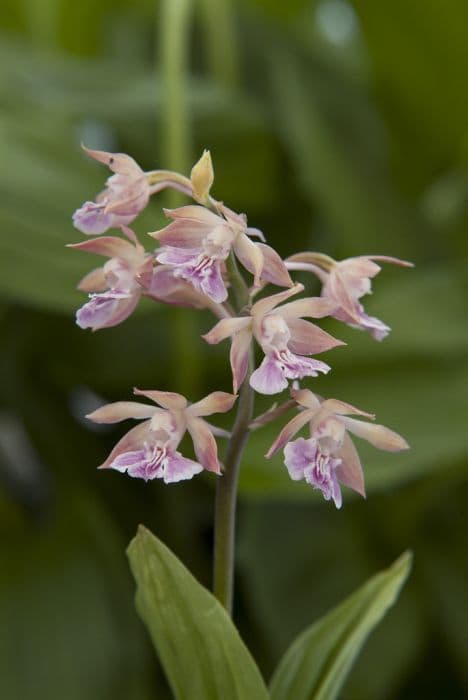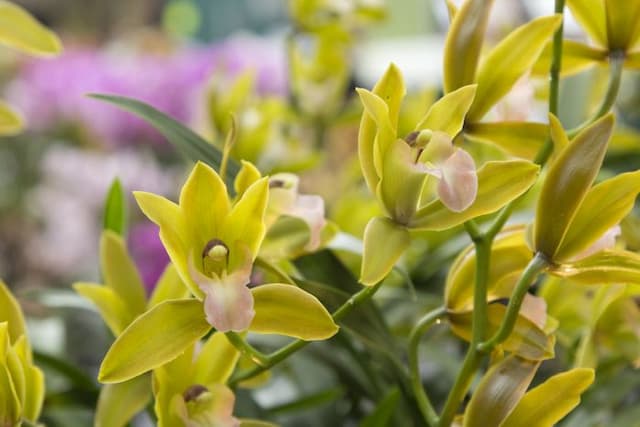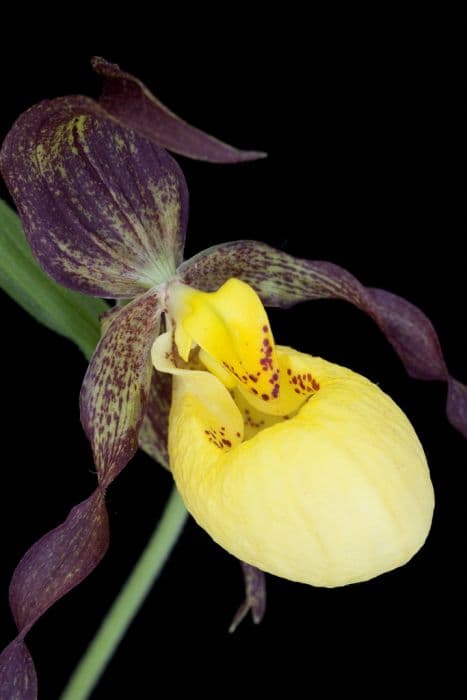Lady's Slipper Orchid Cypripedium Ivory gx

ABOUT
The Cypripedium Ivory gx, commonly known as the Ivory Lady's Slipper orchid, features a distinctive and elegant appearance. Its bloom is particularly striking, characterized by a pouch-like lip that is often a creamy, ivory color, giving the impression of a dainty slipper. This pouch is framed by twisted petals and sepals which can vary in color from soft greens and purples to deeper, richer hues, sometimes displaying delicate veining or spotting patterns. The leaves of the Ivory Lady's Slipper orchid are pleated and can vary in color from a bright, fresh green to a deeper green shade, providing a lush backdrop for the flowers. The foliage often grows in a clump, with the leaves emerging from the base of the plant in a spiraling pattern that adds to the plant's overall texture and form. This orchid's blossom is not only visually appealing but also tactile, with a waxy or slightly velvety texture that invites touch. Its symmetry and the contrast between the smooth, bulbous lip and the more slender, often twisted or wavy petals and sepals create an alluring visual spectacle that makes the Ivory Lady's Slipper highly sought after by orchid enthusiasts and gardeners alike.
About this plant
 Names
NamesFamily
Orchidaceae
Synonyms
Ivory Lady's Slipper
Common names
Cypripedium Ivory gx.
 Toxicity
ToxicityTo humans
Cypripedium Ivory gx commonly referred to as Lady's slipper orchid is not widely known for toxicity to humans when touched or handled. However, ingestion of any part of this plant can lead to stomach upset, with symptoms including nausea, vomiting, and diarrhea. As with any plant, individual sensitivities can vary, so it is best to avoid ingesting any part of the Lady's slipper orchid.
To pets
Lady's slipper orchid, known scientifically as Cypripedium Ivory gx, does not have a well-documented toxicity profile for pets such as cats and dogs. While they are not widely recognized as poisonous to pets, it is generally advisable to prevent pets from ingesting plants. If a pet were to ingest part of a Lady's slipper orchid, it might experience mild gastrointestinal discomfort, including symptoms such as vomiting or diarrhea. If you suspect your pet has ingested any part of this plant, it is wise to consult with a veterinarian.
 Characteristics
CharacteristicsLife cycle
Perennials
Foliage type
Deciduous
Color of leaves
Green
Flower color
White
Height
1-2 feet (30-60 cm)
Spread
1-2 feet (30-60 cm)
Plant type
Herb
Hardiness zones
5
Native area
Asia
Benefits
 General Benefits
General Benefits- Ornamental Appeal: The Cypripedium, commonly known as Lady's Slipper orchid, has a unique and aesthetic floral structure that adds beauty to gardens.
- Biodiversity Support: As a flowering plant, Lady's Slipper orchids provide necessary habitat and food sources for pollinators, contributing to local biodiversity.
- Educational Interest: The Lady's Slipper orchid's unique characteristics make it an intriguing subject for horticultural education and study.
- Conservation Value: Many orchids, including the Lady's Slipper, are of conservation interest, and cultivating them can aid in the preservation of rare and endangered species.
- Therapeutic Landscaping: The Lady's Slipper orchid's distinctive and engaging appearance can be psychologically uplifting and is often used in therapeutic garden settings.
 Medical Properties
Medical PropertiesThis plant is not used for medical purposes.
 Air-purifying Qualities
Air-purifying QualitiesThis plant is not specifically known for air purifying qualities.
 Other Uses
Other Uses- Ornamental Display: The Cypripedium Ivory, commonly known as Lady's Slipper Orchid, is often used for ornate floral arrangements and displays in botanical gardens due to its unique and striking appearance.
- Education and Research: This orchid species can be used in educational settings to teach about plant hybridization and conservation efforts concerning rare and endangered plant species.
- Photography Subject: The Lady's Slipper Orchid provides a captivating subject for nature photographers and plant enthusiasts seeking to capture the beauty of exotic flowers.
- Collectors' Specimen: Due to their rarity and unique beauty, these orchids are sought after by specialized plant collectors and horticulturalists.
- Wedding Decorations: The delicate and unique flowers of the Lady's Slipper Orchid can be incorporated into wedding bouquets or venue decorations for a touch of natural elegance.
- Cultural Symbol: In some cultures, orchids such as the Lady's Slipper are considered symbols of luxury and refinement, and hence are used in various artistic and cultural expressions.
- Eco-tourism Attraction: Regions where the Lady's Slipper Orchid grows naturally may attract visitors interested in seeing this rare orchid in its native habitat.
- Gift Plants: Small potted specimens of the Lady's Slipper Orchid can be given as gifts to plant lovers who appreciate the rarity and challenge of growing such species.
- Green Roofing: In some specialized green roofing projects, the Lady's Slipper Orchid may be incorporated as part of a diverse plant community to increase ecological value and visual interest.
- Bioindicator Agent: The presence of the Lady's Slipper Orchid in the wild can be an indicator of a healthy and undisturbed ecosystem, thus they can be used in environmental quality assessment studies.
Interesting Facts
 Feng Shui
Feng ShuiThe plant Cypripedium, commonly known as Lady's Slipper Orchid, is not used in Feng Shui practice.
 Zodiac Sign Compitability
Zodiac Sign CompitabilityThe Lady's Slipper Orchid is not used in astrology practice.
 Plant Symbolism
Plant Symbolism- Rarity: Known as the Lady's Slipper Orchid, this plant is rare and unique, symbolizing the value and preciousness of uncommon or one-of-a-kind qualities.
- Beauty and Elegance: The Lady's Slipper Orchid is cherished for its delicate and striking appearance, representing the grace and sophistication one can find in nature.
- Femininity: Its resemblance to a slipper or shoe has historically linked it with women's apparel, making it a symbol of feminine strength and beauty.
- Luxury: Due to its rarity and the challenge of cultivation, this plant also stands for luxury and exclusivity.
- Resilience: With the ability to survive in tough conditions, the Lady's Slipper Orchid represents resilience and the ability to thrive despite challenges.
 Water
WaterLady Slipper Orchids require water once a week, increasing to twice during the active growing season. They need a thorough soaking, with excess water allowed to drain to avoid waterlogging. Typically, watering with about a pint of water each time is adequate. During dormancy, reduce watering to once every two weeks.
 Light
LightLady Slipper Orchids thrive in bright, indirect sunlight. They should be placed in a north-facing window or a spot that receives filtered light. Direct sunlight can burn the leaves, so ensure the light is diffused.
 Temperature
TemperatureLady Slipper Orchids prefer temperatures between 50°F and 75°F. They can survive a minimum temperature of 40°F and should not be exposed to temperatures above 80°F. The ideal range is a daytime temperature around 70°F and a slight drop at night.
 Pruning
PruningPruning Lady Slipper Orchids is generally done to remove dead or yellowing leaves and is best performed after flowering. Pruning helps to promote healthy growth and prevents disease. It should be done sparingly, as the plants do not require aggressive pruning.
 Cleaning
CleaningAs needed
 Soil
SoilThe Cypripedium, commonly known as the Lady's Slipper orchid, thrives in a well-draining soil mix with moisture retention properties. A recommended mix consists of one part perlite, two parts fir bark, and one part peat moss to maintain adequate aeration and moisture. The optimal pH range for Lady's Slipper orchids is slightly acidic, between 5.5 and 6.5.
 Repotting
RepottingLady's Slipper orchids should be repotted every one to three years or when the potting medium begins to decompose. It's best to repot in the spring just as new growth appears.
 Humidity & Misting
Humidity & MistingLady's Slipper orchids prefer a humidity level between 40% and 50%. This mimics their natural humid woodland habitats and supports their growth and flowering.
 Suitable locations
Suitable locationsIndoor
Position Lady's Slipper in bright, indirect light, and monitor humidity levels.
Outdoor
Choose a dappled shade area, shield from strong sun, and protect from harsh weather.
Hardiness zone
4-8 USDA
 Life cycle
Life cycleThe Lady's Slipper Orchid, commonly referred to as the Cypripedium Ivory gx, begins its life cycle as a seed, which is uniquely minute and lacks endosperm for initial growth, thus depending on a mycorrhizal fungus to provide vital nutrients. Germination takes place underground in a symbiotic relationship with the fungus, which can last for years before a small shoot emerges from the soil. Once sprouted, the plant develops a rosette of leaves during its juvenile stage, capturing sunlight to build energy reserves for future growth. As the orchid matures, it forms its characteristic slipper-shaped flower, which is pollinated by insects deceived into entering the trap-like blossom, thus ensuring cross-fertilization. After pollination, the plant produces a capsule filled with thousands of dust-like seeds, ready to be dispersed by wind to begin the cycle anew. The Lady's Slipper Orchid then enters a period of dormancy, where it conserves energy in its underground parts, comprising a rhizome and root system, to survive through adverse conditions and regenerate in the following season.
 Propogation
PropogationPropogation time
Spring-Early Summer
The Lady's Slipper Orchid, known scientifically as Cypripedium Ivory gx, is a hybrid orchid and its propagation commonly occurs through division, which is the most popular method for this plant. The ideal time for dividing Lady's Slipper Orchids is in the late summer or early fall, when the plant has finished blooming and is entering a period of dormancy. To propagate through division, carefully unearth the orchid, ensuring minimal damage to the roots. Identify sections of the plant that have their own shoot and a healthy amount of roots. Using a sterile knife or pair of scissors, separate these sections from the main plant. Each divided section should have at least three to four shoots to ensure a good chance of survival. Once the divisions are made, they can be replanted in pots with well-draining soil or directly in a garden under appropriate growing conditions, maintaining typical care for the orchids as they establish themselves.









